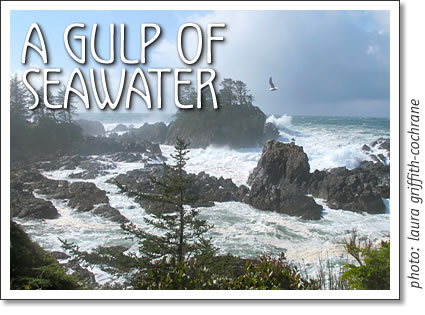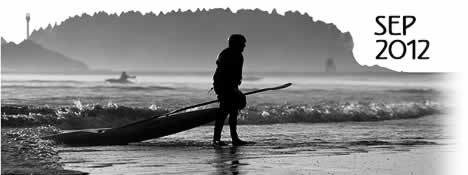
A Gulp of Seawater
by Laura Griffith Cochrane, Ucluelet Aquarium
 We are ocean people. This coastal existence is dependent on or deemed magnificent by our time in the sea, and where we live we have little to fear about dipping ourselves in the salty brine.
We are ocean people. This coastal existence is dependent on or deemed magnificent by our time in the sea, and where we live we have little to fear about dipping ourselves in the salty brine.
How much time do you spend with your head immersed in the salt water? Hours in the surf? Snorkeling missions? Diving through the kelp forests? And after being in the ocean, do you feel anxious about showering immediately after? There are many places in the world where our unconcerned attitudes could get us into trouble. In the more populated areas of southern North America, surfing near cities after a rainfall could leave you with a nasty ear infection. Studies have found divers and surfers with bacterial infections, viruses that set in from open wounds, hepatitis from swallowing contaminated sea water… This is a very different scenario than the one I was exposed to growing up, where a scraped knee earned you a quick dip in the sea because, “the ocean and salt water are good for healing”.
Just as the ocean can have a great affect on us, we greatly affect the ocean. These effects are not always immediate. Neither are they as visible as the plastic that washes ashore. National Geographic recently published a article about studies focusing on a different kind of oceanic contamination: Caffeine. In the Pacific northwest, there is a larger concentration of caffeine in the water. Our coffee addictions are being passed on! The study found that most of the caffeine contamination came from areas where sewage was not treated. However even in the presence of some treatment centres, caffeine is not a chemical of concern and is thus unregulated.
A higher concentration of caffeine in the water so far has unknown effects on the ecosystem. However, the study showed that lab experiments exposing mussels to the concentration of caffeine found in the Pacific Northwest resulted in cellular stress.
Humans excrete other things (of course). Humans naturally release hormones. Hormones are the body’s messenger chemicals. Hormones initiate growth, they tell the body to produce certain chemicals, or to slow production. Interestingly, most animals and plants use the same messengers. Since plants use estrogen as one of their key hormones, we can affect our body by eating certain plants that have higher concentrations of these hormones, such has chocolate which has a higher concentration of it. Soy has a high concentration of estrogen, to the point that a tofu or soy heavy diet can have effects on women’s menstrual cycles. Just as we can be affected by the hormones we ingest, when these chemicals leave our body, they many go on to continue instigating biological processes in other creatures.
Coastal seas have been found to have a high concentration of estrogen. This comes from many sources, including the sheer number of people living on the coast combined with the natural release of estrogen and the synthetic estrogen released from birth control pills. A study conducted in northwestern Ontario exposed a lake to the concentrations of synthetic estrogen from birth control pills found in untreated municipal wastewater. After the first year, male fishes began producing egg proteins in their testes. The second year showed a decrease in sperm production, and into year three of the study, the males began producing eggs. This resulted in a population collapse. Changes in sex occur naturally in many fish and invertebrate species but the introduction of a key sex hormone can skew the population one way or another. Development can be slowed, or halted completely.
There are many studies across North America, and throughout the world, where feminization of male fish has been documented. These include both fresh water and salt water species and have prompted an outcry from many scientists to further refine out waste-water management practices.
Water quality is a multi-faceted and hefty topic. Locally, the sub-genres of this theme rotate around beach cleanups and the impending arrival of tsunami debris. Like our visits to the doctor, most often our knowledge of the state of the oceans comes from an arising problem rather than an interest in prevention. However, we are constantly learning, and while we do so, we can feel lucky to be able to run down the street and jump in the sea with our only worry being it’s chilly temperature.
Laura Griffith-Cochrane is the Assistant Curator of the Ucluelet Aquarium.
Tofino Time September 2012
- September 2012 in Tofino
- Tofino events: September 2012
- Tofino concerts: September 2012
- Tofino movies in September 2012
- Surfboards from Tofino: At the Core of it All
- Ucluelet Aquarium: Gulp of Seawater
- The Floating Gardens at Freedom Cove
- Tofino tide table for September 2012
- Tofino surf reports for September 2012
- Community Directory: Goods & Services in Tofino
tofino | tofino time | activities | accommodation | events | directory
maps | travel | food | art & artists | photos | horoscope | tides
search | magazine | issues | articles | advertising | contact us
hosted in tofino by tofino.net & studio tofino
© 2002-2014 copyright Tofino Time Magazine in Tofino Canada
Ucluelet Aquarium Assistant Curator Laura Griffith-Cochrane writes about water quality in sea water for Tofino Time Magazine in September 2012.

quick links:
- tofino accomodations
- tofino calendar
- tofino surf report
- tofino horoscope
- march horoscope
- tofino map
- tofino fishing report
- tofino tides
- tofino weddings
tofino events:
- tofino concerts
- tofino events
- tofino movies
- tofino festivals
- tofino yoga classes
- tofino whale festival
tofino time magazine:
- tofino time march 2016
- tofino event listings march 2016
- tofino concerts in march 2016
- tofino movies in march 2016
- cox bay | wickaninnish beach
- chesterman beach
- tonquin beach
- tofino brewing co.
- tofino wedding guide
tofino accommodation:
- tofino cabin
- tofino camping
- bed & breakfasts in Tofino
- tofino hostels
- tofino motels
- tofino hotels
- tofino vacation rentals
- petfriendly accommodation
activities:
- tofino bike rentals
- tofino bear watching
- tofino bird watching
- tofino boat charters & cruises
- tofino fishing
- hot springs cove
- sea kayaking in tofino
- tofino storm watching
- tofino surfing
- tofino whale watching
- tofino yoga
shopping:
services:
- tofino yoga, spa & wellness
- tofino restaurants
- tofino internet cafes
- tofino travel & transportation
- tofino real estate
- tofino taxi services
- tofino wedding & events
